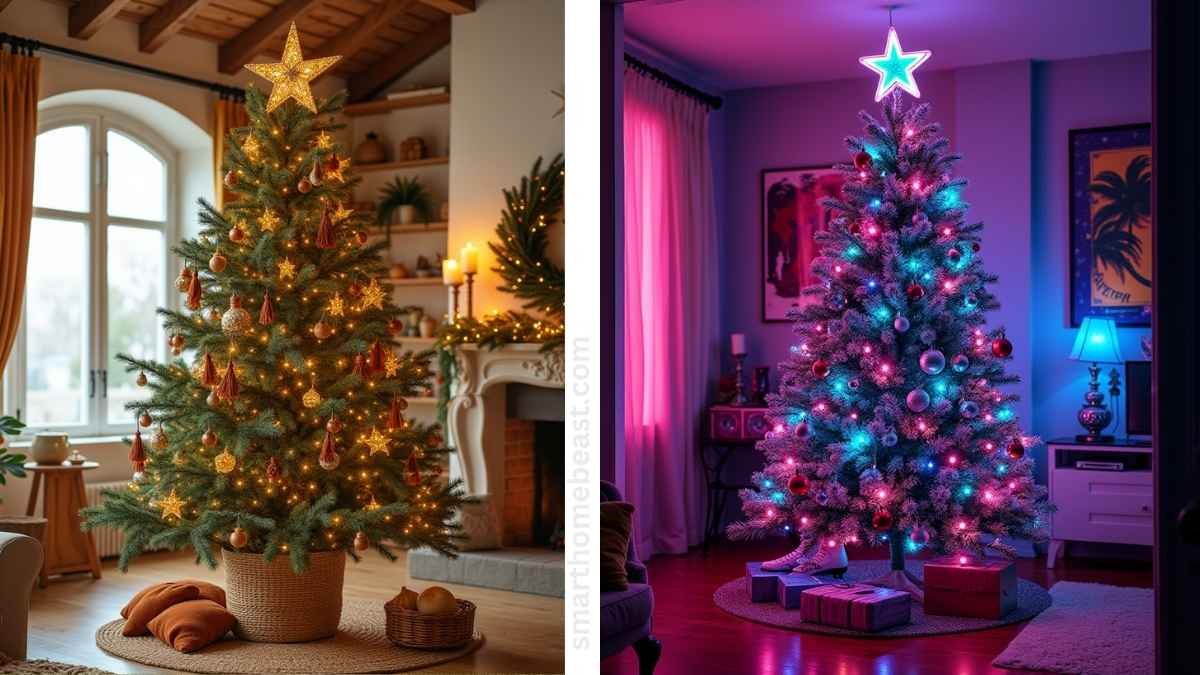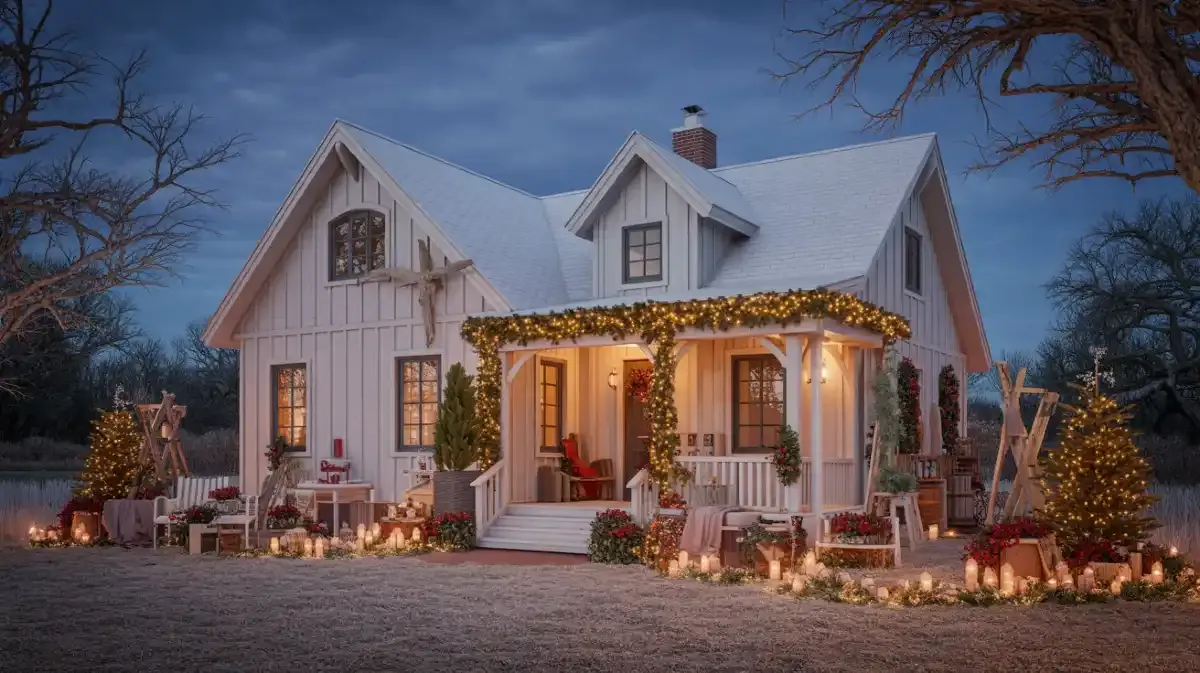
Putting up holiday lights is… well, utterly exhausting sometimes. I mean, I love festive cheer, truly. But every single year, I seem to end up fighting with tangled wires, wondering if it’s even worth all that effort. Perhaps you feel similar?
It’s tough trying to achieve jaw-dropping curb appeal when you’re just busy living life. I’m not saying these twenty-five ideas will magically hang themselves, but they might just make your home a neighborhood favorite without typical chaos.
1. Timeless Elegance: The Architectural Outline
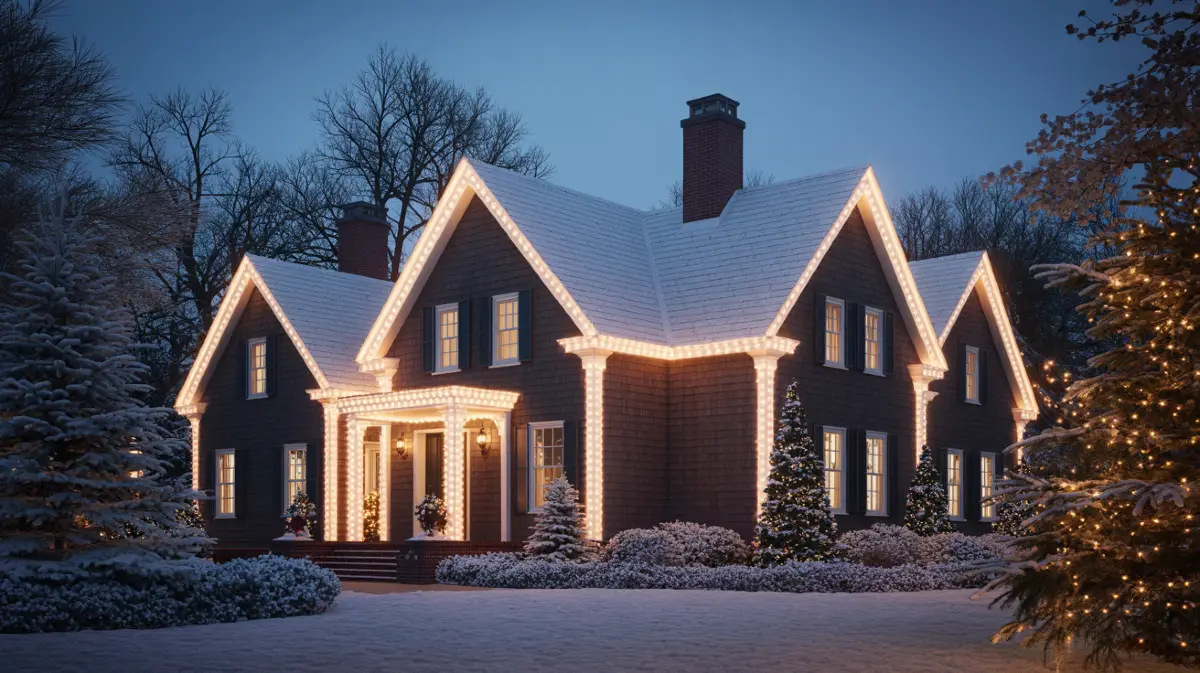
This design is the embodiment of classic, understated sophistication. It eschews whimsical characters and a riot of color in favor of highlighting the home’s inherent architectural beauty. The philosophy here is “less is more,” creating a clean, crisp, and elegant framework that feels both festive and high-end. The light acts as a luminous pencil, precisely tracing the home’s most distinguished features, from its proud roof peaks to its welcoming window casings.
Architectural Suitability: This approach is most effective on homes with strong, defined lines and interesting roof structures. Traditional styles such as Colonial, Georgian, Cape Cod, and Tudor are ideal canvases, as their symmetrical and formal qualities are enhanced by the clean lines of light.
Curated Color Palette: A strict, monochromatic scheme is essential for achieving this look. The choice is between Warm White (approx. 2700K) for a classic, golden glow that feels welcoming and traditional, or Cool White (approx. 5000K) for a more modern, snow-like crispness that evokes a wintery atmosphere.
The key to success is absolute consistency; mixing warm and cool whites within this design would disrupt its harmonious and intentional aesthetic.
Lighting & Materials Blueprint:
Layering & Focal Point Strategy:
Functional Plan:
2. Country Farmhouse Charm: A Rustic Welcome

This design evokes a cozy, nostalgic, and deeply welcoming atmosphere, blending the simplicity of country living with the clean lines of modern farmhouse style.
It prioritizes natural textures, the soft glow of warm light, and elements that feel handcrafted or curated over time, rather than a slick, uniform display. The intended mood is not a dazzling spectacle, but a warm, inviting beacon that beckons guests to come in from the cold.
Architectural Suitability: Perfectly suited for Modern Farmhouse, Craftsman, and Ranch-style homes, as well as any property with a prominent front porch or rustic architectural details.
Curated Color Palette: The lighting is exclusively Warm White (2700K) to create a soft, candle-like ambiance. Accents of muted barn red and deep evergreen are introduced through natural elements—berries, foliage, and ribbons—rather than colored lights, maintaining an organic and sophisticated feel.
Lighting & Materials Blueprint:
Layering & Focal Point Strategy:
- Focal Point: The front door and porch area are the undeniable heart of this design. The Edison lights, glowing lanterns, and decorated planters work in concert to establish this as the primary, welcoming focal point.
- Ambient Layer: The soft, diffuse light from the walkway lanterns provides gentle ambient illumination for the front yard, creating a sense of warmth that extends beyond the porch.
- Task Layer: The same lanterns also serve as crucial task lighting, ensuring a clearly lit and safe path for guests arriving after sunset.
Functional Plan:
3. Victorian Grandeur: A Dickensian Dream

This design transports a home back to the 19th century, capturing the opulent and heartfelt spirit of a classic Dickensian Christmas. It is a celebration of richness, detail, and abundance, characterized by deep colors, intricate patterns, and a warm, gaslight-era glow.
The aesthetic is layered, textured, and unapologetically festive, evoking the grandeur of old-world traditions.
Architectural Suitability: This style is tailor-made for Victorian, Queen Anne, Italianate, or any home featuring ornate architectural details like gingerbread trim, bay windows, turrets, and elaborate porches. The design aims to accentuate, not overwhelm, these intricate features.
Curated Color Palette: A foundation of Warm White (2700K) light is essential to replicate the glow of candlelight and gas lamps. This is layered with a rich, jewel-toned palette of Burgundy, Emerald Green, and Gold introduced through ribbons, ornaments, and select colored bulbs.
Lighting & Materials Blueprint:
Layering & Focal Point Strategy:
- Layer 1 (Architectural Detail): The C7 bulbs tracing the home’s ornate trim work serve as the base layer, highlighting the unique character of the architecture.
- Layer 2 (Ambient Glow): The window candles and enhanced porch lights provide a soft, ambient layer that makes the home feel lived-in and warm.
- Layer 3 (Focal Point): The animated carriage on the lawn acts as the primary accent and focal point, capturing attention and adding a magical, narrative element to the scene.
Functional Plan:
4. Peppermint Twist: Sweet & Spirited
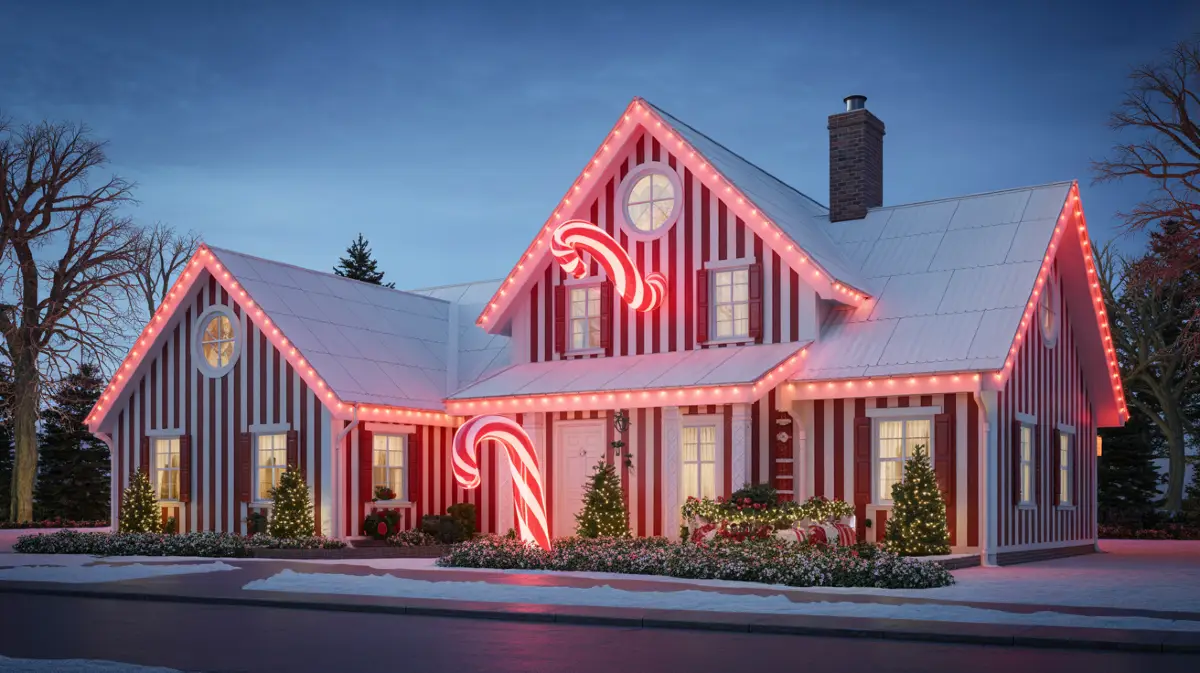
This design is a playful and graphic celebration of one of Christmas’s most iconic treats: the candy cane. It relies on a crisp, high-contrast color scheme and bold, repeating patterns to create a look that is cheerful, whimsical, and visually striking.
The key is to transform the home into a life-sized confectionery creation, using light to mimic the sweet swirls of peppermint.
Architectural Suitability: This theme works exceptionally well on homes with strong symmetrical lines, such as Colonial, Cape Cod, or classic Bungalow styles. The alternating color pattern is most effective when applied to balanced architectural features.
Curated Color Palette: A strict and vibrant two-tone palette of Bright Red and Crisp White. Using LED lights is crucial here, as they produce a more saturated, pure red than their incandescent counterparts.
Lighting & Materials Blueprint:
Layering & Focal Point Strategy:
- Layer 1 (Architectural Pattern): The alternating red and white C9s and spiraling rope lights establish the foundational candy cane pattern directly on the house itself.
- Layer 2 (Themed Pathway): The candy cane markers along the walkway extend the theme into the landscape, creating a clear path and drawing the eye toward the entrance, which serves as the focal point.
- Layer 3 (Textural Contrast): The solid blocks of color from the net-lit shrubs provide a visual resting place and make the striped patterns on the house and trees pop even more.
Functional Plan:
- Power: Ensure that when alternating colors on a single stringer (using C9 bulbs and a separate line), the total wattage does not exceed the stringer’s capacity. LED bulbs make this much easier due to their low power draw. Pathway markers often link together, so be mindful not to connect more than the manufacturer’s recommended number in a single chain.
- Installation: For the spiraling rope light on columns, start at the bottom and secure the end with a clear zip tie. Wrap upwards, maintaining even spacing, and secure the top end similarly. Use lawn stakes for all pathway markers and DIY elements to ensure they remain upright and stable throughout the season, even in snow or wind.
- Visual Balance: Achieving a pleasing rhythm with the alternating colors is key. Plan the spacing of the C9 bulbs on the roofline so that the pattern appears consistent from the street. A 12-inch spacing is standard and works well for this effect.
6. Santa’s Workshop: Whimsical & Wonderful
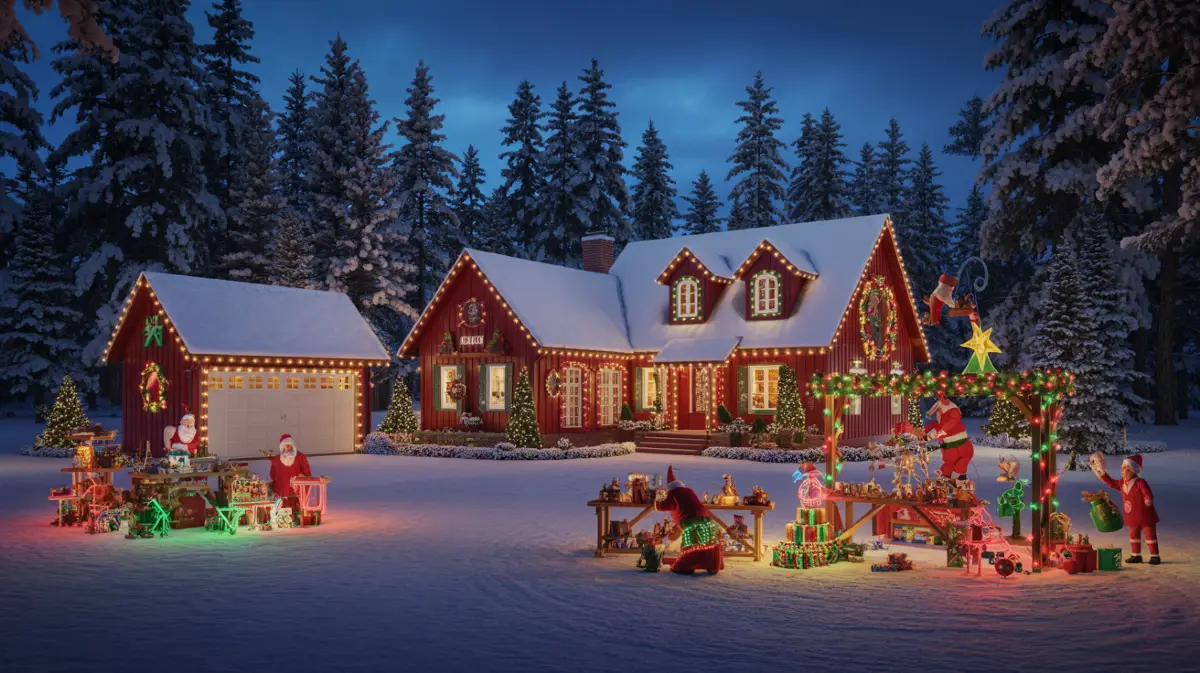
This design transforms the home and yard into a bustling, magical scene straight from the North Pole. It is a narrative-driven theme, filled with fun, nostalgia, and a sense of wonder that appeals to all ages.
The aesthetic is bright, busy, and full of character, telling the story of Santa and his elves preparing for the big night. This is a maximalist approach that prioritizes joy and whimsy.
Architectural Suitability: This theme is highly adaptable and can work with almost any style of home. It is particularly effective for homes with a detached garage or a separate workshop-like structure that can be designated as the “official” workshop. A large front lawn provides ample space for creating different scenes.
Curated Color Palette: A vibrant and classic Multicolor scheme is the go-to for this look. Bright reds, greens, blues, and yellows create a festive and energetic atmosphere reminiscent of classic Christmas cartoons and storybooks.
Lighting & Materials Blueprint:
Layering & Focal Point Strategy:
- Layer 1 (Backdrop): The multicolor lights on the house provide a festive, ambient backdrop for the entire display.
- Layer 2 (The Main Scene): The workshop area and the large sleigh inflatable serve as the primary focal points, immediately establishing the theme.
- Layer 3 (Supporting Characters): The smaller vignettes of elves and reindeer populate the rest of the yard, adding depth, detail, and narrative elements that encourage the eye to wander and explore the entire space.
- Layer 4 (Dynamic Effects): The projectors and animated elements add a final layer of magic and engagement, capturing attention and making the scene feel alive.
Functional Plan:
- Power: This is a power-intensive display. Inflatables require a constant power source for their fans, and multiple animated figures add to the load. It is essential to use multiple GFCI-protected circuits to distribute the power safely. Use heavy-duty outdoor power stakes and timers to manage the various elements.
- Installation: Inflatables and large wire-frame figures must be securely anchored to the ground using the provided stakes and tethers. In areas with high winds, additional anchoring may be necessary to prevent them from taking flight.
- Circulation: When placing elements on the lawn, consider the viewing experience from the street and sidewalk. Create a clear visual hierarchy so the scene doesn’t look cluttered. Ensure that figures and cords do not obstruct public walkways or create tripping hazards.
7. Winter Wonderland: A Frosted Monochrome Landscape
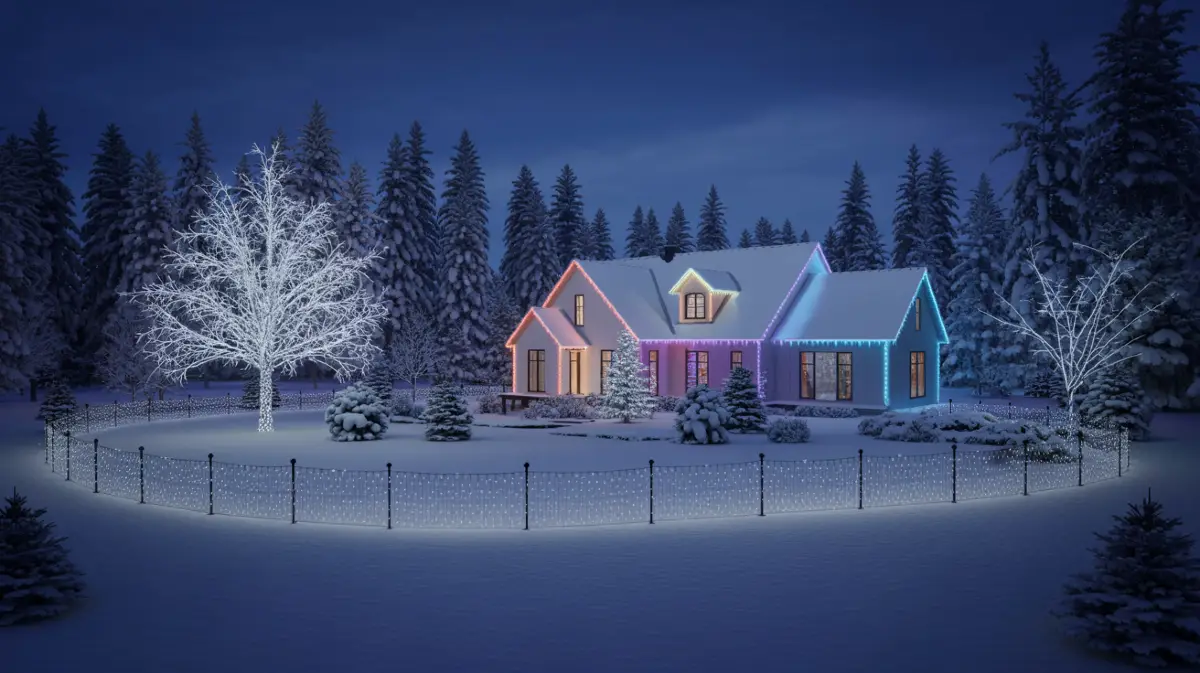
This design aims to transform the entire property into a magical, snow-covered landscape, creating an immersive winter experience even in the absence of real snow. It relies on a strictly controlled monochromatic palette and a variety of light textures to mimic the complex beauty of a world blanketed in snow and ice.
The goal is a cohesive, ethereal environment that feels both grand and serene. A successful monochrome design is not about using a single type of light; it is about using multiple textures of light within the same color family to create visual interest and depth.
The interplay between the static grid of net lights, the sharp lines of wrapped branches, and the dynamic flow of a snowfall projector creates a rich, multi-layered experience that a single light type could never achieve.
Architectural Suitability: While versatile, this theme is particularly striking on modern homes with simple geometry, as the clean white light accentuates their forms. It is also highly effective on homes with dark-colored exteriors (such as navy, charcoal, or black), where the bright white and blue lights create a dramatic, high-contrast effect.
Curated Color Palette: A crisp, two-tone palette of Cool White (5000K-6000K) and Sapphire Blue is the foundation of this look. The cool white serves as the base color, representing snow, while the sapphire blue acts as a strategic accent, suggesting the deep shadows of a winter night or the crystalline blue of glacial ice.
Lighting & Materials Blueprint:
Layering & Focal Point Strategy:
- Framework: The icicle lights on the roof and the net lights on the shrubs create the foundational “snow-covered” base layer across the property’s main structures.
- Texture & Depth: The meticulously wrapped trees add verticality and intricate, sculptural detail. The snowfall projector introduces a crucial layer of movement and ethereal texture against the home’s façade.
- Focal Points: The large snowflake motifs and lighted animal figures are strategically placed to serve as key focal points, drawing the eye to specific areas of the yard and breaking up the uniformity of the base layers.
Functional Plan:
- Power: This is a high-density display that requires careful power planning. Map out the location of all GFCI outlets and use heavy-duty outdoor power stakes with multiple outlets and built-in timers. It is critical to adhere to the manufacturer’s guidelines on the maximum number of light strings that can be connected end-to-end to prevent circuit overloads and fire hazards.
- Installation: Wrapping trees is a labor-intensive but high-impact technique. The process is most efficient when starting from the base of the trunk and working upwards, wrapping each major branch individually. For reaching higher branches safely from the ground, a simple tool can be made by duct-taping a bent wire coat hanger to the end of an extension pole. Net lights are a significant time-saver for shrubs and hedges.
8. Starry Night: Celestial Elegance

This design draws inspiration from the deep, clear wonder of a winter night sky. It is an ethereal and sophisticated theme that uses light to create a sense of magic and infinite space.
Rather than brightly illuminating the entire house, this approach uses darkness as a canvas, peppering it with points of light that mimic stars, constellations, and distant galaxies.
Architectural Suitability: This concept is ideal for properties with large, mature deciduous trees, which provide a natural canopy for hanging lights. It also works well for homes with large, dark roofs or expansive front lawns where the “stars” can be spread out.
Curated Color Palette: The base color is a deep, rich Sapphire Blue, representing the night sky. This is accented with points of Warm White or Gold, which stand in for the stars and celestial bodies, creating a beautiful contrast between cool and warm tones.
Lighting & Materials Blueprint:
Layering & Focal Point Strategy:
- Ambient Layer: The base layer of blue light establishes the “night sky” canvas and sets the mystical mood.
- Texture Layer: The twinkling fairy lights woven through the foliage add a layer of fine, shimmering texture.
- Focal Points: The large Moravian stars and starbursts serve as the primary focal points, drawing the eye upward and creating dramatic points of interest within the scene.
- Immersive Layer: The laser projector adds a final, immersive layer that fills the entire space with movement and light, tying all the other elements together.
Functional Plan:
- Power: Distribute power to trees using outdoor-rated extension cords, secured along the ground with landscape staples to prevent tripping hazards. For hanging stars, run a single cord up the trunk and along a main branch, then use smaller connector cords to power individual stars.
- Installation: Hanging stars securely in tall trees is the main challenge. Use a sturdy ladder with a spotter, or an extension pole with a hook. Use clear fishing line or thin, dark-colored wire to hang the stars so that the suspension is invisible at night. Position laser projectors at an angle and distance that provides the widest and most effective coverage without shining directly into windows or onto public roadways.
9. Gilded Glamour: A Metallic Masterpiece
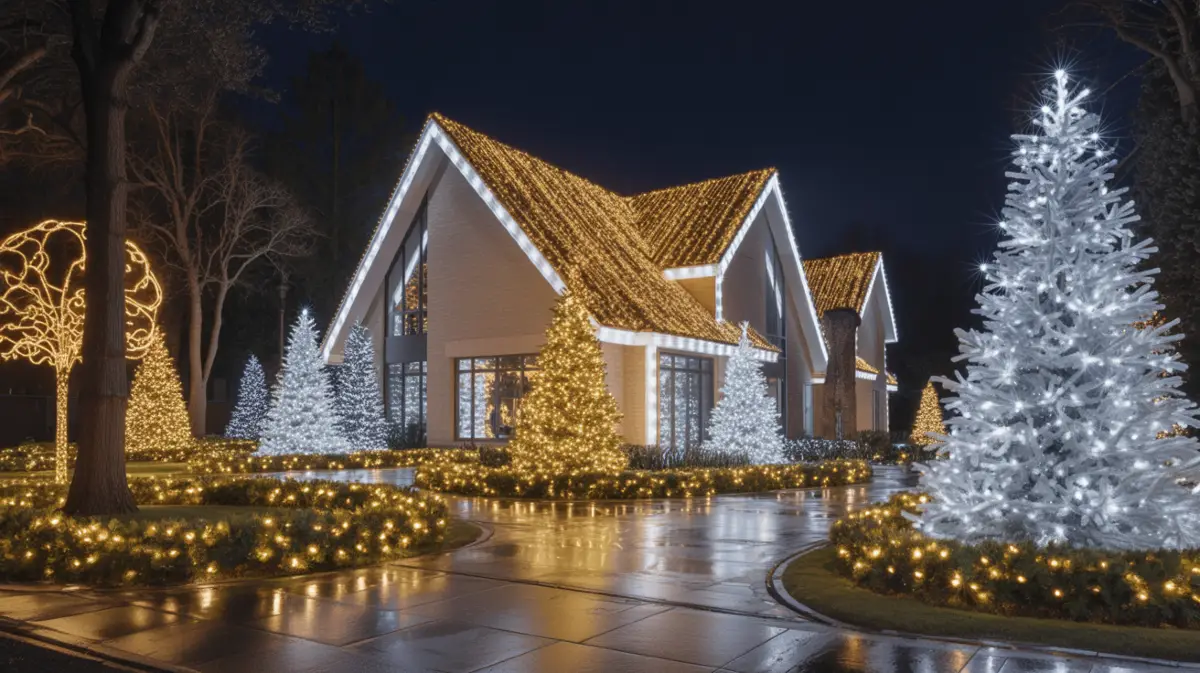
This design is the epitome of modern luxury and sophistication. It moves away from traditional Christmas colors entirely, opting instead for a chic and glamorous palette of shimmering metals.
The look is clean, elegant, and highly reflective, creating a display that sparkles and glows with an expensive-feeling warmth. It’s about texture, reflection, and the interplay of warm and cool metallic tones.
Architectural Suitability: Best suited for Modern, Contemporary, or even Art Deco-style homes. The clean lines and simple forms of these architectural styles provide a perfect, uncluttered backdrop for the metallic theme to shine.
Curated Color Palette: A refined two-tone palette of Gold and Silver. This can be achieved with actual gold and silver colored lights or, more commonly, by pairing Warm White (for gold) and Cool White (for silver) LED lights. The contrast between the warm, sunny glow of gold and the crisp, icy shimmer of silver is the core of the design’s appeal.
Lighting & Materials Blueprint:
Layering & Focal Point Strategy:
- Framework: The single-color outline of the house establishes the main structure and defines the architectural form.
- Contrast & Depth: The contrasting color used in the landscape provides depth and separates the house from the yard.
- Geometric Accents: The lighted orbs and starbursts act as sculptural, geometric focal points, adding a modern art-like quality to the display.
- Dynamic Sheen: If using smart lights, the animated effects provide a final layer of sophisticated movement and shimmer.
Functional Plan:
- Power: Smart light systems require a good Wi-Fi signal to reach the outdoor controllers. You may need a Wi-Fi extender for larger properties. Ensure all controllers and power supplies are housed in weather-resistant boxes and elevated off the ground.
- Installation: Fairy lights on fine wire can be delicate. Handle them with care during installation to avoid breakages. When creating DIY spheres, wear gloves to protect your hands from the chicken wire and use zip ties to secure the light strings to the frame.
- Daytime Appearance: One of the benefits of this theme is its strong daytime appeal. The metallic wire of the lights and the finish on the orbs and starbursts will catch the sunlight and look like intentional sculptural elements even when not illuminated.
10. Minimalist Modern Glow: Less is Luminous

In a landscape of ever-brighter and more complex displays, this design makes a powerful statement through restraint.
It is the antithesis of holiday clutter, focusing on a single, perfectly executed lighting element to create a look that is clean, architectural, and profoundly intentional. The goal is not to decorate the house, but to use light as a sculptural element that interacts with the home’s modern form.
Architectural Suitability: This approach is designed for Modern, Mid-Century Modern, and Minimalist architecture. Homes with clean lines, interesting geometric forms, large panes of glass, or unique materials (like board-formed concrete or COR-TEN steel) are the perfect subjects.
Curated Color Palette: A strict, monochromatic scheme of either Warm White (approx. 3000K) or Pure White (approx. 4000K). The choice depends on the desired mood: warm white softens modern lines and feels more inviting, while pure white emphasizes the crisp, geometric nature of the architecture.
Lighting & Materials Blueprint:
Layering & Focal Point Strategy: This design philosophy intentionally rejects layering. The entire concept is the focal point. By isolating a single element—a wall, a sphere, a line, a tree—it is given immense visual weight and importance. The surrounding darkness is just as important as the light itself, as it frames the illuminated subject.
Functional Plan:
- Quality over Quantity: Since the focus is on a single element, the quality of the light fixtures is paramount. Invest in high-quality, architectural-grade uplights or commercial-grade lighting that will produce a clean, even beam of light.
- Concealment: The success of this look depends on hiding the source of the light. All cords, stakes, and fixtures should be completely concealed from view. Wires should be buried in mulch or run discreetly along architectural seams.
- Precision: Placement is everything. Experiment with the angle and distance of uplights to get the most dramatic shadow effects. Ensure that any geometric lines created with rope light are perfectly straight and have clean corners. A spirit level and careful measurement are essential tools.
- Power: With so few lights, power is not a major concern, but a timer is still recommended for convenience and energy efficiency. The connection to the GFCI outlet should be as discreet as possible.
11. Rustic Woodland Retreat: Forest Charm

This design brings the quiet, cozy beauty of a forest cabin in winter to any home. It emphasizes natural materials, soft, warm light, and textures that evoke a sense of warmth and shelter. The aesthetic is organic, unrefined, and deeply connected to the outdoors, featuring elements like birch logs, pinecones, and woodland creatures.
Architectural Suitability: Ideal for Log Cabins, A-Frame houses, Craftsman bungalows, and any home with natural wood or stone siding. It also works well for homes situated in a wooded or naturalistic setting.
Curated Color Palette: The lighting is exclusively Warm White (2700K). The color palette is dominated by the natural tones of Deep Greens, Earthy Browns, and the White of Birch Bark. Accents of deep red can be added through berries or plaid textiles.
Lighting & Materials Blueprint:
Layering & Focal Point Strategy:
- Ambient Layer: The lanterns and the soft glow from the garlands create a warm, welcoming ambient light around the entryway.
- Texture Layer: The primary focus is on texture. The rough bark of logs, the intricate pattern of pinecones, the smooth surface of birch, and the soft needles of the greenery are all highlighted by the delicate fairy lights.
- Focal Points: The illuminated woodland creature figures and the brightly lit entryway serve as the main focal points, drawing the eye and establishing the theme.
Functional Plan:
- Power: This design lends itself well to a combination of plug-in and battery-operated lights. Use plug-in lights for the main garlands and entryway, and use battery-operated fairy lights with timers for the lanterns and yard vignettes to maintain a clean, cord-free look.
- Materials: Source natural materials responsibly. If gathering branches or pinecones from your property, ensure they are clean and dry before bringing them onto a porch. For longevity and ease, high-quality faux natural elements can be just as effective.
- Safety: Keep flammable materials like dry leaves, burlap, and pine needles a safe distance from any plug-in light bulbs that might generate heat, although this is less of a concern with cool-running LED lights.
12. Enchanted Forest: A Mystical Experience

This design transforms the yard into a mystical, otherworldly forest filled with magic and wonder. It’s less about a cozy cabin and more about stepping into a fairy tale. The lighting is subtle, mysterious, and designed to play with shadow and color, creating an immersive experience that feels alive and magical.
Architectural Suitability: This theme is most effective for homes surrounded by mature trees. The trees themselves are the primary canvas, with the house acting as a backdrop or a castle deep within the woods.
Curated Color Palette: A magical palette of Deep Green, Warm White, and Gold. The green light creates the forest atmosphere, while the warm white and gold provide the enchanting sparkle.
Lighting & Materials Blueprint:
Layering & Focal Point Strategy:
- Base Layer (Canopy): The green uplighting on the tree canopy establishes the immersive forest environment.
- Mid-Layer (Sparkle): The fairy lights and firefly effects create a shimmering mid-layer that adds depth and magic.
- Ground Layer (Guidance): The pathway lights guide visitors through the space and add interest at ground level.
- Accent Layer: The spotlights on specific features and the moving laser lights provide the final layer of detail and dynamic wonder.
Functional Plan:
- Power: This is another design that requires careful planning to get power to multiple locations throughout a yard. Use outdoor-rated extension cords and bury them under mulch or secure them with landscape staples to avoid tripping hazards.
- Light Placement: The key to this design is subtlety and creating a sense of mystery. Avoid harsh, direct lighting. Position lights so they are partially obscured by leaves or branches to create dappled light and interesting shadows.
- Weather: A fog machine is only effective on nights with little to no wind. Consider its use as a special occasion enhancement rather than a nightly feature. Ensure the machine and its power connection are rated for outdoor use.
13. Coastal Christmas: Seaside Serenity

This design brings a breezy, relaxed, and serene coastal vibe to the holidays. It trades snowflakes for starfish and heavy evergreen for light, airy textures. The aesthetic is calm and natural, using a color palette inspired by the sea and shore to create a peaceful holiday retreat.
Architectural Suitability: A natural fit for Beach Houses, Cape Cods, and Coastal Modern homes, but it can also bring a fresh, unexpected twist to any style of home, especially in warmer climates.
Curated Color Palette: A light and airy palette of Aqua, Seafoam Green, Sandy Beige, and Crisp White. The lighting should be a mix of Warm White (like sunlight on sand) and Cool White (like the glint of water).
Lighting & Materials Blueprint:
Layering & Focal Point Strategy:
- Base Texture: The net lights on the greenery provide a base layer of color and a distinct, net-like texture.
- Linear Elements: The rope garlands create strong horizontal lines that guide the eye along railings and fences.
- Focal Points: The driftwood tree sculpture and the seashell wreaths on the door and windows serve as the primary focal points, clearly defining the coastal theme.
- Ambient Glow: The illuminated glass floats add a soft, scattered ambient light at ground level.
Functional Plan:
- Materials: Use authentic materials like rope and driftwood, but ensure they are clean and treated if necessary. For durability, especially in harsh weather, high-quality faux coastal elements are available.
- Power: The scattered nature of this design, with its various vignettes, is another good candidate for a mix of plug-in and battery-powered lights with timers to avoid a tangle of cords.
- Attachment: Securely attach rope garlands with zip ties or wire. When hanging wreaths on windows, you can use suction cup hooks or the traditional method of looping a ribbon over the top of the window sash and securing it on the inside.
14. Tropical Tidings: Island Greetings
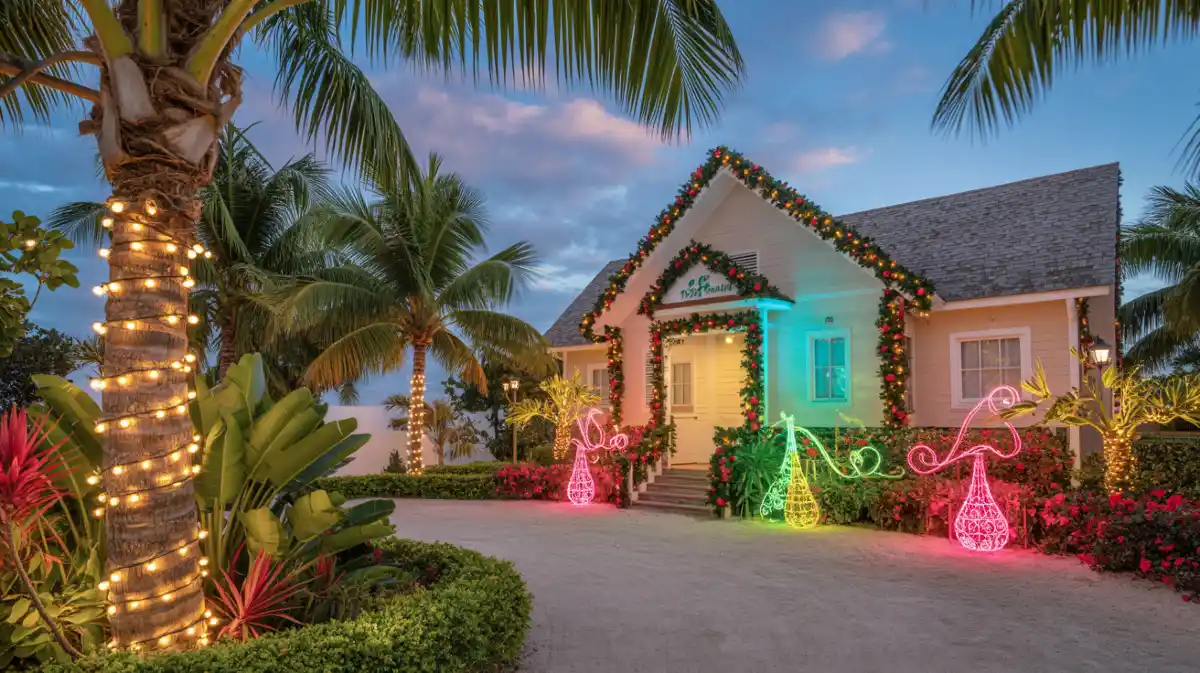
This design embraces the warmth and vibrancy of the tropics, proving that Christmas doesn’t have to be a wintery affair. It uses lush foliage, bright colors, and island-inspired motifs to create a festive and fun “Mele Kalikimaka” atmosphere. The look is cheerful, relaxed, and full of sunshine.
Architectural Suitability: Perfect for homes in warm climates, especially those with Tropical, Mediterranean, or Key West architectural styles. It’s also a fun and unexpected theme for any home looking to escape the cold.
Curated Color Palette: A base of Warm White light is complemented by a vibrant palette of Hot Pink, Turquoise, Lime Green, and Sunny Yellow, inspired by tropical flowers and fruits.
Lighting & Materials Blueprint:
Layering & Focal Point Strategy:
- Vertical Elements: The illuminated palm trees provide the main vertical structure and immediately set the tropical scene.
- Color & Theme: The bright floral lights and pineapple motifs establish the color palette and reinforce the island theme.
- Texture: The lush, oversized leaves of the tropical garlands provide a different texture from traditional pine, adding to the exotic feel.
- Focal Point: A cluster of brightly lit palm trees or a large, welcoming pineapple display at the entrance serves as the primary focal point.
Functional Plan:
- Light Selection: In a theme that embraces color, LED lights are the best choice for their vibrant, saturated hues and energy efficiency.
- Weatherproofing: Even in warmer climates, outdoor decorations need to be weather-resistant. Ensure all lights, cords, and figures are rated for outdoor use and can withstand rain and humidity.
- Balance: With so many bright colors and fun shapes, it’s important to create a sense of balance. Avoid placing too many different elements close together. Create distinct zones—a flamingo area, a pineapple path—to keep the display from looking chaotic.
15. Retro Kitsch Christmas: A Technicolor Throwback

This design is a vibrant and playful homage to the Mid-Century Modern Christmas aesthetic of the 1950s and 60s. It embraces bold, unconventional colors, atomic-age shapes, and a healthy dose of kitschy fun. The look is nostalgic, graphic, and full of personality, featuring aluminum trees, bubble lights, and shiny Brite-style ornaments.
Architectural Suitability: A perfect match for Mid-Century Modern, Ranch, and Split-Level homes. The clean, horizontal lines of these homes provide an excellent canvas for the retro decorations.
Curated Color Palette: A classic mid-century palette of Hot Pink, Turquoise (Aqua), Cherry Red, and Lime Green. This is not a theme for subtlety; the colors should be bright and saturated.
Lighting & Materials Blueprint:
Layering & Focal Point Strategy:
- Architectural Outline: The large, colorful C9 bulbs on the house provide the main structure and color story.
- Focal Point: The silver tinsel tree with its rotating color wheel is the undeniable star of the show, immediately signaling the retro theme.
- Narrative Elements: The blow mold figures populate the yard, adding character and a nostalgic, storybook quality to the display.
Functional Plan:
- Sourcing: Finding authentic vintage blow molds and color wheels can be part of the fun (check flea markets and online sellers). However, many companies now produce new, more durable and energy-efficient LED versions of these classic decorations.
- Power: Vintage decorations, if used, should have their wiring thoroughly inspected for safety. It’s often safer to use modern reproductions. Blow molds and projectors will require multiple outlets, so a power stake with a timer is essential.
- Placement: Group blow mold figures together in a scene rather than scattering them randomly. For example, place the choir singers near the front door as if they are caroling for guests.
16. Gingerbread Delight: A Sweet Façade
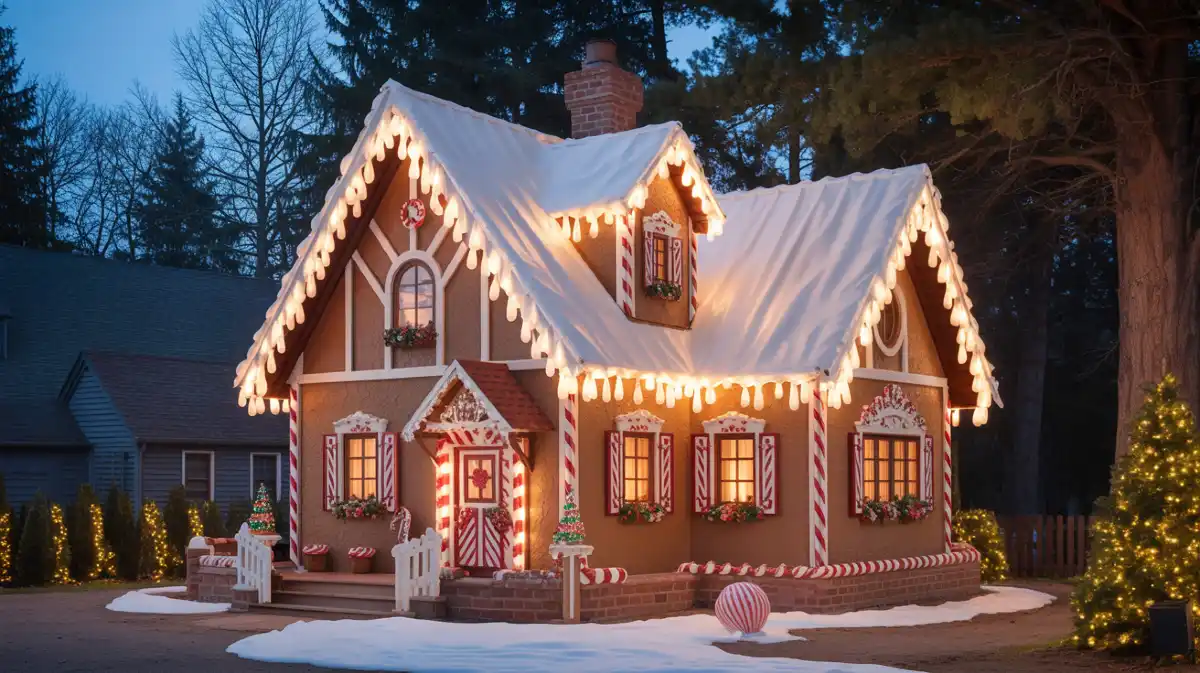
This design transforms the home into a life-sized gingerbread house, straight out of a fairy tale. It’s a sweet, whimsical, and enchanting theme that uses light and decoration to mimic the look of frosting, candy, and baked goods. The aesthetic is charming, detailed, and delicious-looking.
Architectural Suitability: This theme is particularly charming on Cottage, Bungalow, and Tudor-style homes, as their cozy and often intricate features lend themselves well to being decorated like a storybook house.
Curated Color Palette: A warm and inviting palette of Warm White (as frosting), with accents of Red, Green, and Multicolor lights representing various candies.
Lighting & Materials Blueprint:
Layering & Focal Point Strategy:
- Architectural Icing: The white rope light provides the foundational “frosting” layer, defining the shape of the house.
- Candy Details: The gumdrop lights, candy canes, and other colorful elements add the next layer of sweet detail.
- Character & Story: The gingerbread figures provide the narrative element and act as a primary focal point near the door.
Functional Plan:
- Rope Light Installation: Rope light can be stiff, especially in cold weather. It’s helpful to unroll it and let it warm up indoors before installation to make it more flexible. Use rope light clips or channels for a straight, clean installation.
- DIY Elements: When creating DIY candy decorations, ensure all materials are weather-resistant. Use outdoor-rated paint and sealants, and make sure any electrical components are designed for exterior use.
- Visual Cohesion: The key to a successful gingerbread house theme is to apply the “decorations” consistently. If you “frost” the main roofline, you should also frost the garage and any dormers to make the entire property look like a single, cohesive creation.
17. Multicolor Holiday Celebration
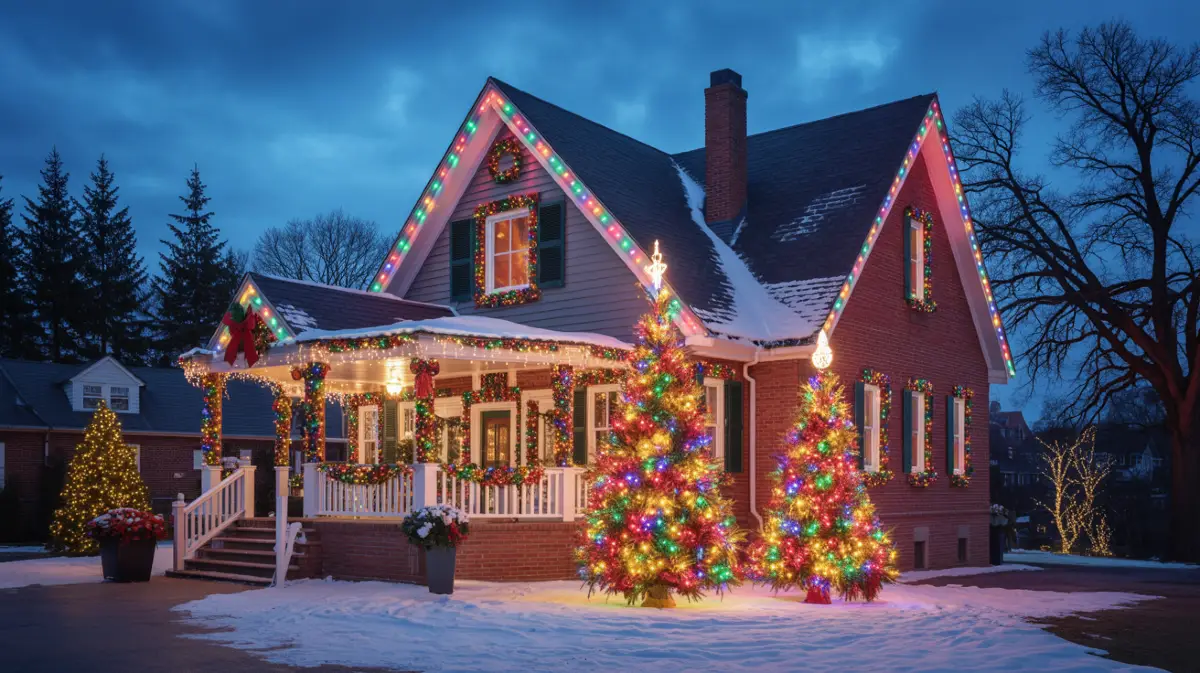
This design is a joyful and energetic embrace of classic Christmas nostalgia, characterized by a vibrant, multicolor palette. It creates a fun, festive, and family-friendly atmosphere that is both visually dense and deeply welcoming. The philosophy is one of abundance and cheer, transforming the home’s entrance into a brilliant beacon of holiday spirit.
Architectural Suitability: This versatile theme works well on a variety of home styles, but is particularly effective on traditional homes with brick or darker-colored exteriors, as the bright, saturated colors create a stunning contrast. Homes with a prominent porch, columns, and railings provide the perfect structural elements to showcase this light-heavy design.
Curated Color Palette: A classic and vibrant Multicolor scheme featuring rich reds, emerald greens, sapphire blues, and sunny yellows. Using LED lights is recommended to achieve the most vivid and saturated colors.
Lighting & Materials Blueprint:
- Primary Focal Point (Porch Tree):
- Tree: A full-sized, dense artificial Christmas tree (6-7 ft) placed prominently on one side of the porch.
- Lighting: Densely wrapped with multicolor 5mm wide-angle conical LED mini lights for maximum brightness and a “glowing from within” effect.
- Porch Structure:
- Columns: Tightly wrap each porch column from base to top with multicolor mini lights. The goal is to create solid pillars of light, which requires wrapping the strands closely together.
- Railings: Similarly, wrap the handrails and balusters with multicolor mini lights for a continuous flow of color.
- Eaves/Overhang: Outline the entire porch roofline with larger, classic C9 multicolor LED bulbs to create a bold, graphic frame for the scene below.
- Entryway:
- Wreath: A thick, 24-inch evergreen wreath on the front door, interwoven with its own set of multicolor mini lights and adorned with a large, weather-resistant red velvet bow.
- Ground-Level Accents:
- Gift Boxes: Arrange several empty boxes wrapped in metallic red, green, and gold paper on the porch steps. Place small, battery-operated fairy light strings inside each to make them glow softly.
- Figurines: A small, classic Santa Claus figure placed near the gift boxes adds a narrative touch.
Layering & Focal Point Strategy:
Functional Plan:
- Power: A display this dense requires significant power. Plan to use at least two separate GFCI-protected outdoor outlets to avoid overloading a single circuit. A multi-outlet, heavy-duty outdoor power stake with a built-in timer is essential for managing the multiple strands efficiently and safely.
- Installation: Use all-purpose light clips for attaching the C9 stringers to the gutters or shingles. For wrapping columns and railings, use clear or green zip ties at the start and end of each strand, pulling them snug but being careful not to pinch the wires.
- Stability: The porch tree must be secured against wind. Place the tree stand in a heavy-duty planter or a weighted wooden crate. You can also use discreet guy wires (like dark fishing line) to anchor the top of the tree to the porch columns or house wall.
18. Southwestern Holiday
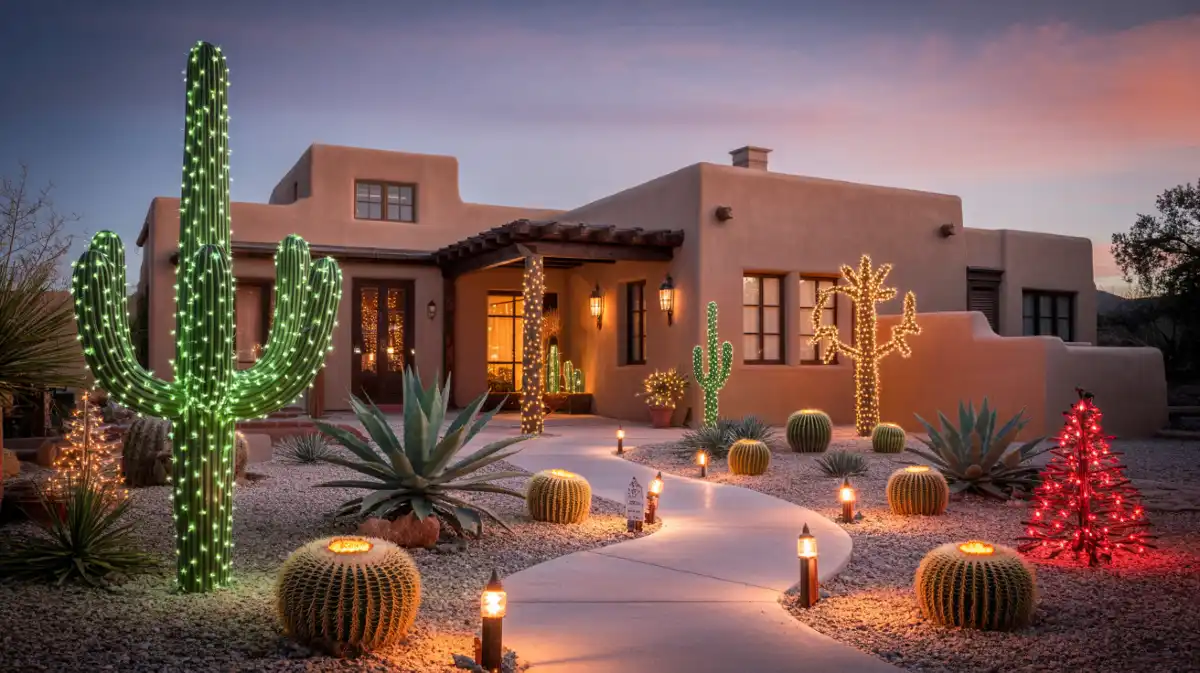
This design celebrates the unique beauty and culture of the American Southwest, swapping traditional winter motifs for desert-inspired elements, warm colors, and the soft glow of luminarias. The aesthetic is warm, rustic, and spiritual.
- Architectural Suitability: Perfectly suited for Adobe, Pueblo Revival, and Spanish Mission homes, but also works for Ranch-style homes or any house with stucco exteriors.
- Curated Color Palette: A warm and earthy palette featuring Warm White light, accented by the natural colors of Terracotta, Turquoise, and Chili Red.
- Lighting & Materials Blueprint:
- Luminarias (Farolitos): The quintessential element. Line walkways, driveways, and flat roof edges with luminarias made from paper bags with sand and battery-operated tea lights.
- Rope Light Cacti: Shape green rope light into the form of a Saguaro or Prickly Pear cactus and mount them on a wall or create freestanding versions.
- Chili Pepper Lights: Drape strings of red chili pepper lights (ristras) along porch railings or around doorways.
- Architectural Outlining: Use warm white C9 bulbs to outline the unique parapets and vigas of Adobe-style homes.
- Layering & Focal Point Strategy:
- Guiding Light: The luminarias provide the foundational layer of light, serving as both decoration and essential task lighting for pathways.
- Thematic Accents: The rope light cacti and chili pepper lights are the primary thematic elements.
- Focal Point: A large, multi-armed rope light Saguaro cactus in the front yard serves as the central focal point.
- Functional Plan:
- Safety: Battery-operated LED tea lights are a much safer and more practical option for luminarias than real candles.
- Weather Resistance: In areas with heavy rain or snow, use plastic or ceramic luminarias instead of paper bags for durability.
19. Nutcracker Ballet

Inspired by the timeless magic of the ballet, this design transforms the home’s entrance into a grand stage set for The Nutcracker. It is an elegant, theatrical, and sophisticated theme that uses classic characters and dramatic lighting to create a sense of wonder.
- Architectural Suitability: Best for homes with a formal, symmetrical façade, such as Neoclassical, Georgian, or Colonial styles. A prominent entryway is the perfect “stage.”
- Curated Color Palette: A regal palette of Royal Red, Metallic Gold, and Deep Blue, with Warm White light providing the primary illumination.
- Lighting & Materials Blueprint:
- The Sentinels: The core of the design is a pair of life-sized, lighted nutcracker figures flanking the front door.
- Dramatic Uplighting: Use warm white or amber-colored uplights aimed at the front door and the nutcracker figures to create a stage-like effect.
- Lush Garlands: Drape thick, luxurious garlands around the door frame, woven with gold ribbon, large ornaments, and warm white mini lights.
- Window “Curtains”: Hang warm white curtain lights inside prominent front windows to create the look of a glowing, festive interior.
- Layering & Focal Point Strategy:
- Focal Point: The illuminated front door, flanked by the two nutcrackers, is the absolute focal point.
- Atmospheric Layer: The uplighting creates the theatrical atmosphere.
- Framing: The lush garlands frame the scene, adding texture and richness.
- Functional Plan:
- Securing Figures: Life-sized nutcracker figures can be top-heavy and should be secured with weights or discreet tethers in windy locations.
- Scale: The nutcrackers should be substantial enough to make a statement relative to the size of the entryway.
20. The Window Box Jewel
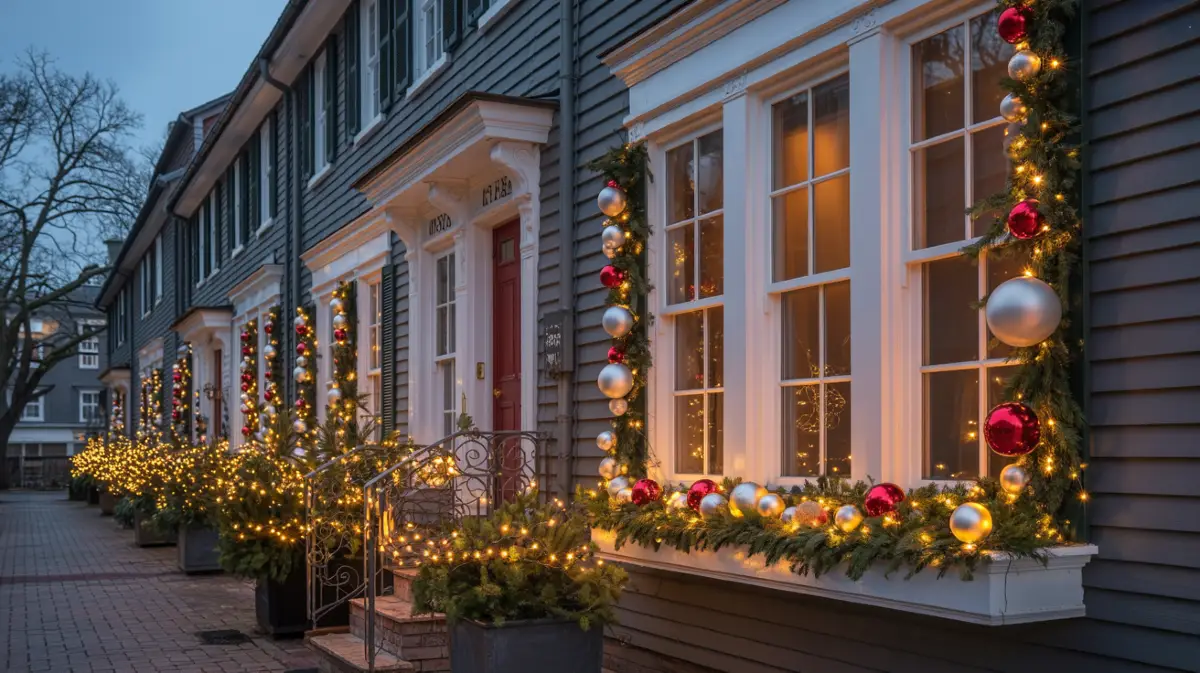
This design treats the home’s windows as individual stages, creating a series of beautiful, glowing vignettes. It’s a perfect solution for townhouses, row houses, or any home where the façade is the primary canvas. The look is elegant, detailed, and offers stunning curb appeal from both day and night perspectives.
21. The Vertical Light Cascade
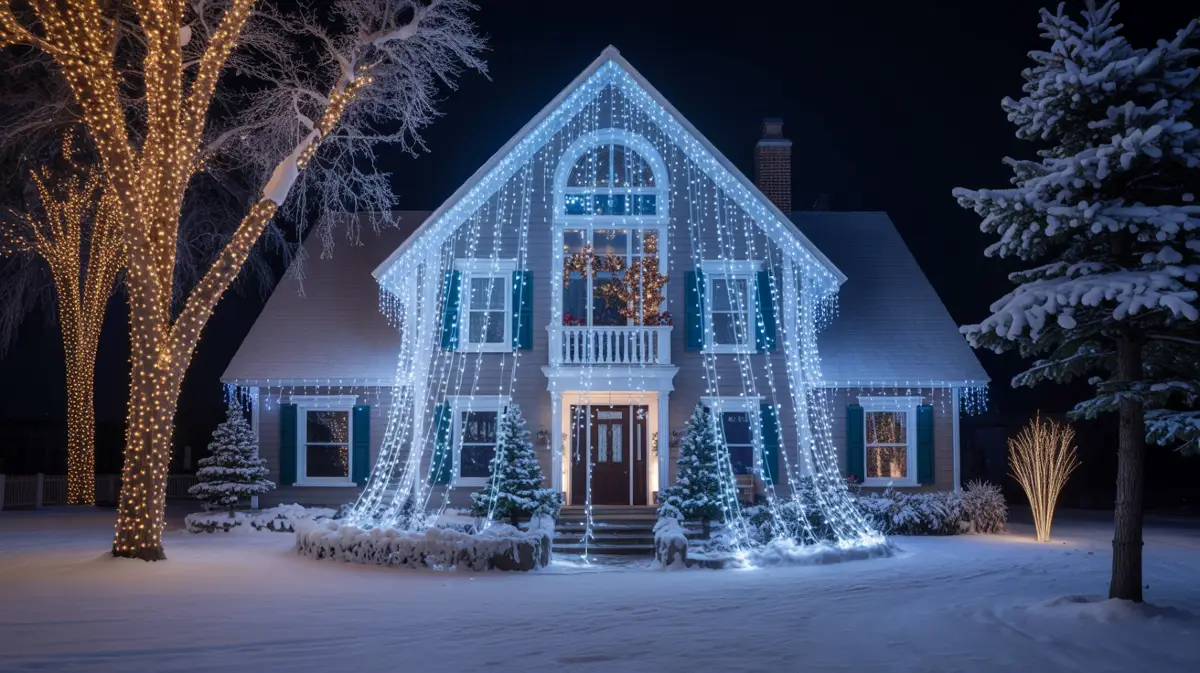
For homes with limited width, this design draws the eye upward, creating a dramatic and high-impact statement using vertical space. A single, breathtaking cascade of light becomes the entire show, turning the home’s façade into a shimmering waterfall of light.
- Architectural Suitability: Best for two-story homes or houses with a prominent front-facing gable or peak.
- Curated Color Palette: A striking monochromatic choice of either Cool White (for an icy, frozen waterfall look) or Warm White (for a shower of golden light).
- Lighting & Materials Blueprint:
- The Cascade: The central feature is a set of cascading micro LED lights or “waterfall” lights hung from the highest peak of the roofline, flowing down towards the ground. For a more dynamic effect, use light tubes with a “dripping icicle” animation.
- Supporting Lights: Keep all other lighting minimal to let the cascade be the star. A simple, pre-lit wreath on the front door is all that’s needed to complete the look.
- Focal Point: The highest point of the cascade serves as the origin point, with the light flowing down to the entrance, naturally making the front door the secondary focal point.
- Functional Plan: This design requires careful and safe installation at a high point. Always use a sturdy, appropriate ladder with a spotter. Ensure the main light feature is securely anchored at the top to withstand wind and weather. A single timer connected to a GFCI outlet can control the entire display.
22. Symmetrical Greenery Glow
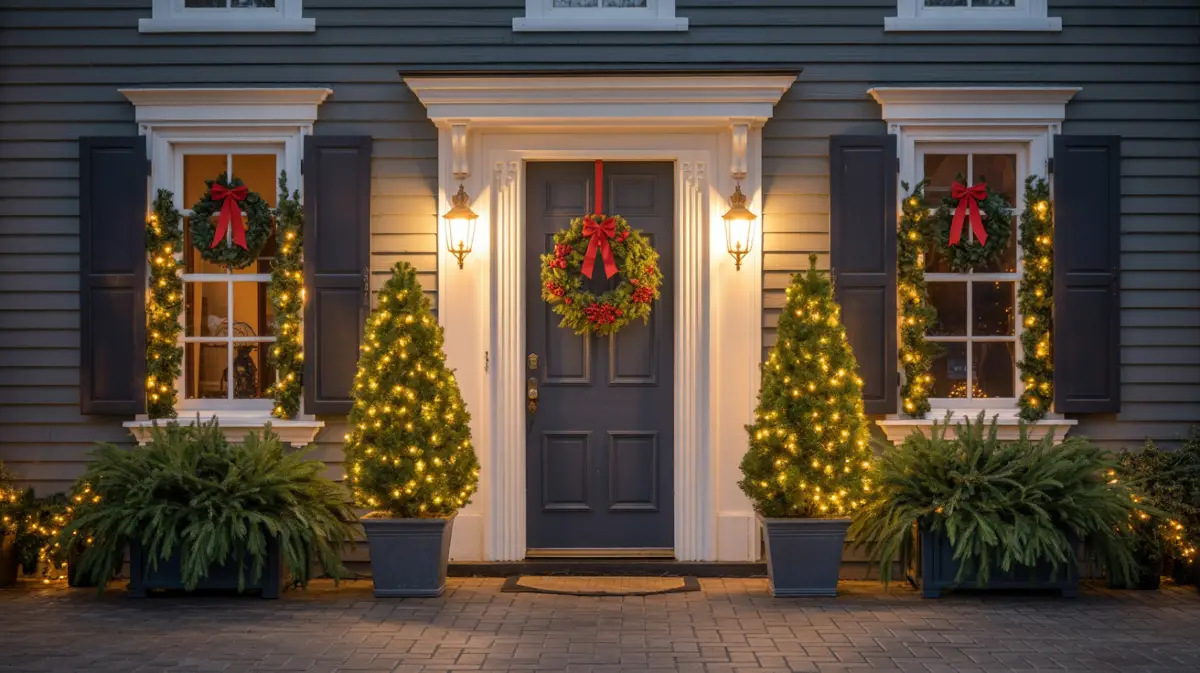
This design is the epitome of classic, timeless elegance. It relies on perfect balance and symmetry, using lush greenery and warm light to create a formal, welcoming, and impeccably polished look. It’s an exercise in restraint and precision.
- Architectural Suitability: Tailor-made for symmetrical homes like Colonial, Cape Cod, or Georgian styles, where the architecture provides a balanced canvas.
- Curated Color Palette: Exclusively Warm White light paired with deep, natural Evergreen and classic Red accents.
- Lighting & Materials Blueprint:
- Entryway Frame: Flank the front door with two identical, perfectly manicured potted evergreens or topiaries, either pre-lit or wrapped neatly with warm white mini lights.
- Door & Windows: Hang a single, identical wreath on the front door and on each window that flanks the door. Each wreath should be adorned with a matching classic red bow.
- Garlands: Drape a single, thick pre-lit garland over the door frame, ensuring it hangs evenly on both sides. If you have porch railings, drape them symmetrically as well.
- Functional Plan: The key to this look is precision. Use a measuring tape to ensure wreaths are hung at the same height and garlands have the same amount of swag on each side. Use a single type and color temperature of light throughout the entire display for a cohesive, high-end feel.
23. The Glowing Gift Box Porch
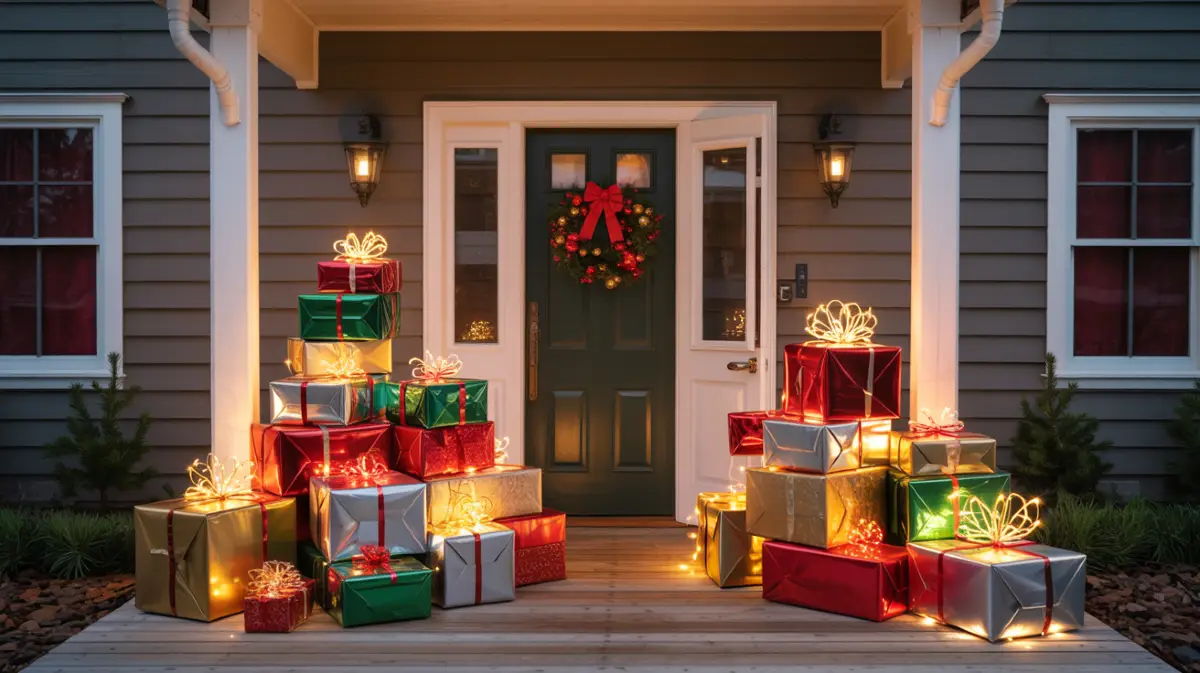
A whimsical and charming theme that transforms the front porch into a delightful pile of glowing Christmas presents. This design is contained, easy to execute, and creates a high-impact focal point right at the entrance.
- Architectural Suitability: Perfect for any home with a covered front porch or a defined entryway space.
- Curated Color Palette: A festive mix of Warm White light with wrapping paper in Reds, Greens, Golds, and Silvers.
- Lighting & Materials Blueprint:
- Glowing Gifts: Collect several empty shipping boxes of various sizes. Wrap them in weather-resistant metallic or foil gift wrap. Before sealing the last flap, place a small string of battery-operated warm white fairy lights inside each box, allowing them to cast a magical glow from within.
- Arrangement: Stack and arrange the glowing gift boxes in artful piles on the porch, concentrating them near the front door.
- The Final Touch: Treat the front door as the largest gift of all by affixing a giant, weather-resistant red bow to the center.
- Functional Plan: Using battery-operated lights with timers for the boxes keeps the porch floor free of tripping hazards from extension cords. Secure the lightweight boxes to each other with double-sided tape or to the porch with removable adhesive to prevent them from blowing away in winter winds.
24. Single Statement Tree
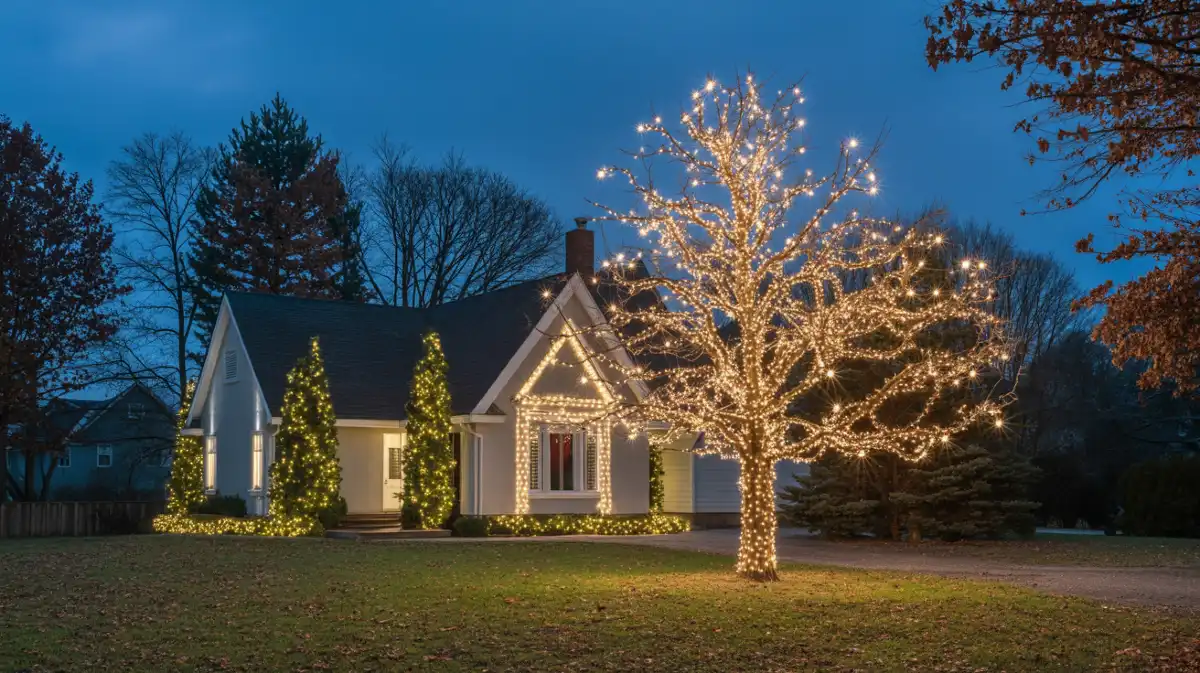
This minimalist approach is perfect for a small yard that features one beautiful, well-placed tree. The design focuses all decorative energy on this single natural element, turning it into a living sculpture of light while the house remains a quiet, dark backdrop.
- Architectural Suitability: Works for any style of home that has a single, prominent deciduous or evergreen tree in the front yard.
- Curated Color Palette: A brilliant monochromatic scheme of either Warm White, Cool White, or a single vibrant color like Blue or Red.
- Lighting & Materials Blueprint:
- The Tree: The entire display is the tree. For a deciduous tree, meticulously wrap the trunk and as many individual branches as possible with mini lights. This highlights the tree’s natural structure and creates an intricate, sculptural look. For an evergreen, drape strings of lights vertically or use net lights for even coverage.
- Light Choice: Use bright, 5mm wide-angle conical LED mini lights to make the tree truly pop against the darkness.
- House: The house itself remains unlit, which amplifies the impact of the single illuminated tree, making it the undeniable focal point.
- Functional Plan: Wrapping a tree can be labor-intensive but yields stunning results. Use an extension pole with a hook to reach higher branches safely from the ground. Run a single, outdoor-rated extension cord discreetly to the base of the tree.
Certainly. Here is another unique idea, crafted to evoke the sophisticated and magical atmosphere of a big city during the holidays.
25. Christmas in the City: Urban Elegance
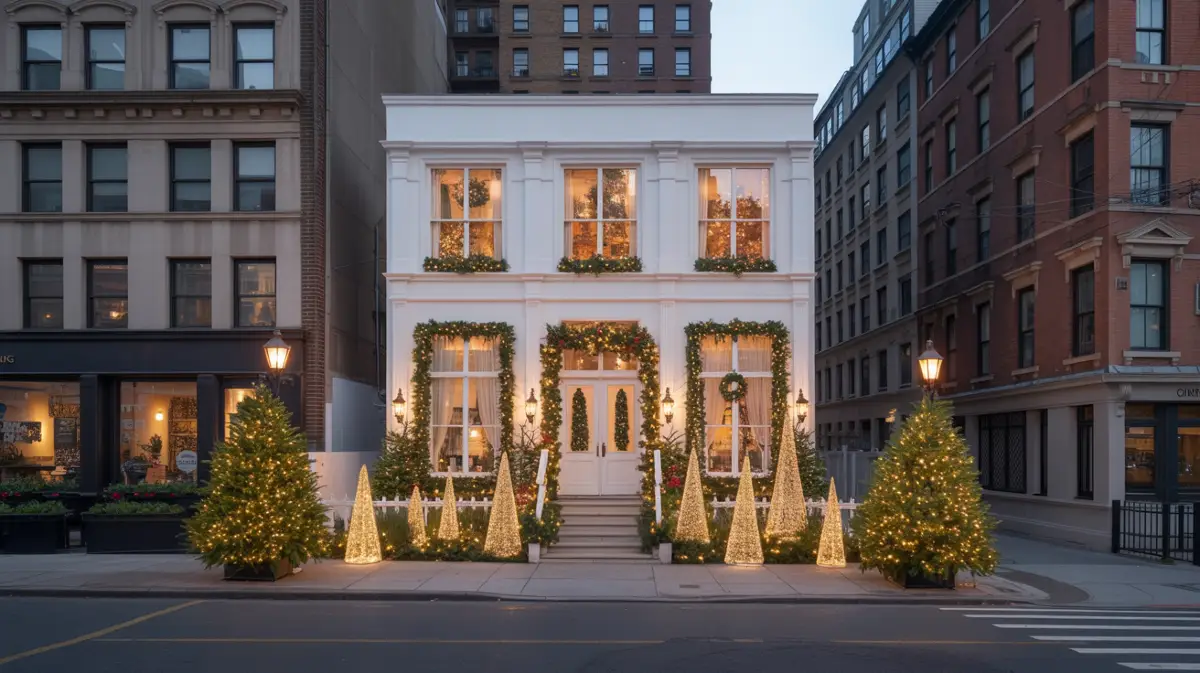
This design captures the chic and sparkling feeling of Christmas in a bustling metropolis like New York or London. It moves away from lawn displays to focus on the home’s façade, creating an elegant, storefront-style welcome. The aesthetic is polished, glamorous, and refined, emphasizing window displays, vertical lines, and a warm, luxurious glow.
- Architectural Suitability: Ideal for Brownstones, Townhouses, and modern homes with large picture windows and limited front yard space. The focus is on the architecture itself, not the landscape.
- Curated Color Palette: A chic and simple palette of Warm White and Metallic Gold. This combination feels luxurious, warm, and timelessly elegant.
- Lighting & Materials Blueprint:
- Window Displays: The main feature is creating beautiful, layered displays inside each front-facing window. This could be a small, perfectly decorated Christmas tree, a collection of glowing gift boxes, or a miniature village scene. Light these displays from within using mini lights or small spotlights.
- Curtain Lights: Hang dense curtains of warm white or gold micro-LED lights down the entire height of the façade or inside large windows. This creates a stunning, shimmering wall of light that is very impactful and sophisticated.
- Architectural Highlighting: Use warm white mini lights to crisply outline the window frames and the main doorway. For a townhouse, draping lights down the front steps and railings is also highly effective.
- Elegant Greenery: Use high-quality, pre-lit wreaths and thin garlands with warm white lights. Add simple gold ball ornaments and wide, gold satin ribbons. A single, beautiful wreath on the front door is a key element.
- Layering & Focal Point Strategy:
- Façade as Canvas: The curtain lights create a glittering base layer that treats the entire front of the building as a single canvas.
- Window Vignettes: The individual window displays act as jewel boxes, each a separate, detailed focal point that draws the viewer in for a closer look.
- Architectural Framing: The lights outlining the windows and door provide a clean, structural frame for the entire design, adding depth and definition.
- Functional Plan:
- Interior/Exterior Coordination: This design requires planning both the interior and exterior lighting together. The window displays are lit from the inside, so you’ll need accessible interior outlets near the windows. Use timers for both interior and exterior lights to ensure they all turn on and off in unison.
- Installation on Masonry: Attaching lights to brick or stone façades requires non-damaging clips, such as brick clips that grip the mortar lines, or using existing hooks or fixtures. Avoid drilling into historic masonry.
- Safety & Access: Decorating a multi-story façade can be challenging. A professional-grade extension ladder or professional installers might be necessary for higher floors. Always prioritize safety.





